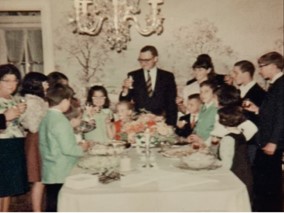The Post-war Years: A Time of Expansion
Mirroring the community as a whole, the 1950s were a boom time for the Anshe Emeth Sunday School as youths aged into their schooling years. By 1954 Sunday School students were coming from Greenville, Piqua, Pitsburg, Sidney, and Troy. As families grew, so too did Anshe Emeth and its resources. From 1950 to 1955 the congregation had enough funds to secure the services of a Sunday School principal, Morton Kanter. Prior to moving to Piqua, Morton served in World War II and he was a Hillel staff member at Miami University. He was also a student at Hebrew Union College before being ordained in 1955. Morton left Piqua later in that same year to take a position as assistant rabbi at Temple Israel in Dayton. The growth of the Sunday School also contributed to the addition of a one-story kitchen and social hall at the back of Anshe Emeth in 1958. This addition, which was built at the cost of $25,000, was used to house the Sunday School’s classes and provide additional event space for the congregation. Frank Albright and Seymour Perlis served as co-chairman of the building committee.At the time, it was estimated Anshe Emeth had between 35 and 40 member families.
The year 1958 also marked the centennial of Anshe Emeth, and the anniversary was observed with appropriate functions. Rabbi Stanley Chyet, a research fellow at the American Jewish Archives in Cincinnati, was the principal speaker at the congregation's anniversary celebration. In this same year, the congregation dedicated a new Torah scroll, which was donated by Gertrude Flesh. The Sisterhood, which sponsored events such as an annual Purim dinner and Passover seder, also expanded. Around 30 women were affiliated with the Sisterhood during the mid-1950s. Presidents or past-presidents during this period included, Jean Kahn, Blanche Louis, Libbie Murstein and Sally Shuchat. Libbie was known in the local Jewish community for hosting an annual Rosh Hashanah kiddush at her home in memory of her husband, Elliott, who died in 1955. This holiday gathering occurred at the Murstein home for at least 29 years. Libbie’s legacy of hospitality continues into the 21st century through the Libbie Murstein Hospitality Fund, which supports onegs, or shared Shabbat gatherings, and a communal break-the-fast meal following Yom Kippur for Anshe Emeth congregants.

 B’nai B’rith also grew its activities. Members sponsored an annual dinner at Hotel Fort Piqua, and in 1958 the lodge began a tradition of recognizing an annual “Man of the Year”. Harry Bell, who was active in promoting local Community Chest fundraisers, was the first recipient. Community Chest was a precursor to United Way. In 1959, Reverend Albert Dixon, a Baptist minister in Troy received the award in recognition of his work to promote public recreation. Presidents of B’nai B’rith during the 1950s and 1960s include Isadore Brotkin, Joseph Kastner, Elliott Murstein and Herbert Perlis. Other members at the time were Louis Berman, Zale Freed, Samuel Freiberg, Clarence Goldberg, Frank Greene, Herman Musman, Max Rose, David Saidelman, and Daniel Taubman.
B’nai B’rith also grew its activities. Members sponsored an annual dinner at Hotel Fort Piqua, and in 1958 the lodge began a tradition of recognizing an annual “Man of the Year”. Harry Bell, who was active in promoting local Community Chest fundraisers, was the first recipient. Community Chest was a precursor to United Way. In 1959, Reverend Albert Dixon, a Baptist minister in Troy received the award in recognition of his work to promote public recreation. Presidents of B’nai B’rith during the 1950s and 1960s include Isadore Brotkin, Joseph Kastner, Elliott Murstein and Herbert Perlis. Other members at the time were Louis Berman, Zale Freed, Samuel Freiberg, Clarence Goldberg, Frank Greene, Herman Musman, Max Rose, David Saidelman, and Daniel Taubman.
It is of note that Clarence and his wife, Dottie, were residents of Pitsburg, Ohio. This village, which was home to 359 people in 1950, is located southwest of Piqua. While Clarence lived in Pitsburg, he worked in Laura, Ohio, at the Roark Furs and Roark Furniture companies. In 1959, he retired and moved to Florida with Dottie. Retirements and young adults moving away from the Upper Miami Valley would stagnate growth, and eventually diminish the size of the local Jewish community by the early 1970s. This population trend was reflected in the area as a whole. Piqua, Greenville, Sidney, and Troy all recorded slower levels of population growth from 1960 to 1970 than they did in the decade between 1950 to 1960. Demographic stagnation continued from 1970 to 1980, and in Piqua’s case there was a population decline of 1.3 percent. The opening of Interstate 75 by the late 1960s also encouraged Jewish families in the Upper Miami Valley to affiliate with synagogues in the Dayton area, which were larger and able to offer a wider range of services. The Anshe Emeth B’nai B’rith lodge continued to be active into the late 1970s, but it likely faded out during the 1980s. The Anshe Emeth Sisterhood likely ceased to function by the early 1970s.